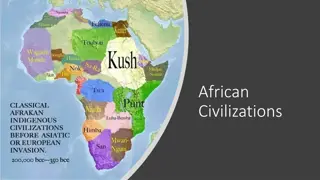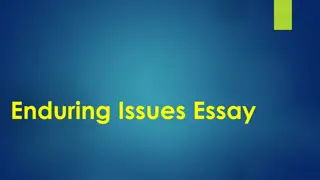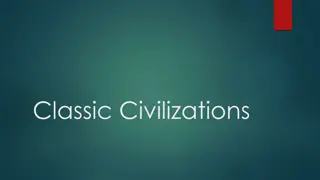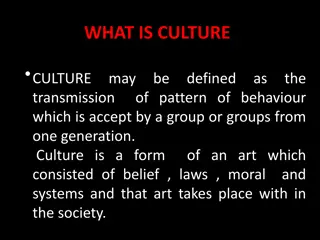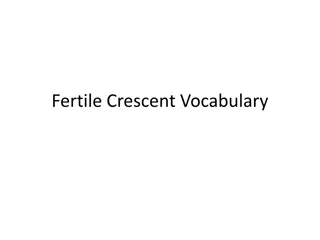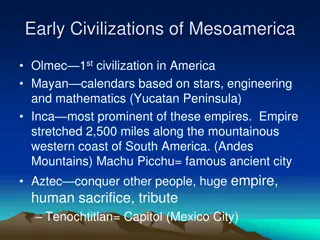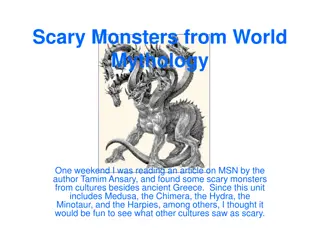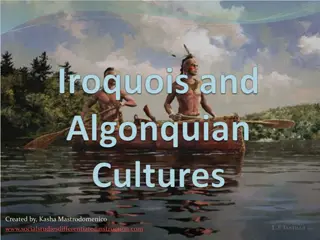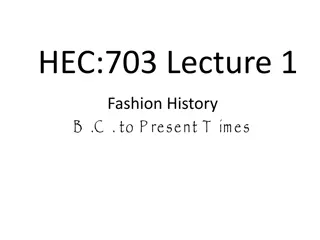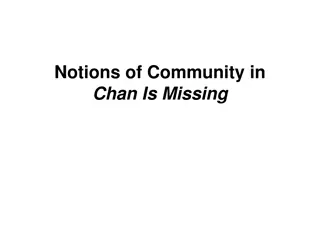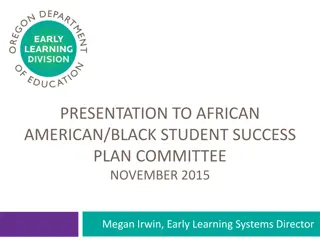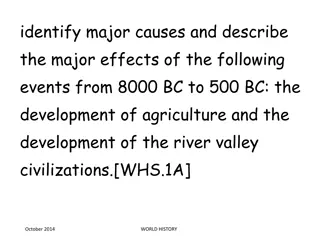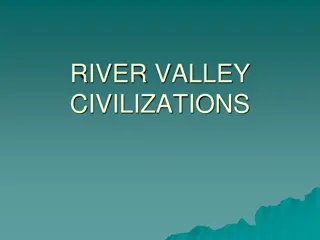Exploring Early American Civilizations and Cultures
The journey through Chapter 1 delves into the collision of worlds between Native Americans and European settlers from 1450 to 1600. It uncovers the experiences of the first Americans, the rise of American empires like the Aztec and Incan civilizations, and the development of chiefdoms and confederacies in regions like the Mississippi Valley and Eastern Woodlands. Discover the rich history of diverse cultures, intricate societies, and fascinating traditions that shaped the early Americas.
Download Presentation

Please find below an Image/Link to download the presentation.
The content on the website is provided AS IS for your information and personal use only. It may not be sold, licensed, or shared on other websites without obtaining consent from the author. Download presentation by click this link. If you encounter any issues during the download, it is possible that the publisher has removed the file from their server.
E N D
Presentation Transcript
CHAPTER 1 CHAPTER 1 COLLIDING WORLDS COLLIDING WORLDS (1450 (1450- -1600) 1600) The Native American Experience The Native American Experience
The First Americans The First Americans -13,000-3,000BC Archaeologists suggest migration of peoples into Americas across Bering Land Bridge during Ice Age -Western Hemisphere cut off from Eastern Hemisphere for 300 generations as ice melts, seas rise, land bridge submerges -Migrants pushed southward, concentrating most in Central Mexico and Andes Mountains region -6000BC Domestication of crops maize (corn) and potatoes; food surpluses led to large population growth
American Empires American Empires Characteristics shared by both Aztec and Incan Empires: Dense populations (Mexico est. 20 million in 1500CE; Peru est. 12 million in 1500CE) Productive agriculture Aggressive bureaucratic state - king/emperor ruled over warrior-nobles System of tribute exploited from surrounding conquered peoples Practice of human sacrifice employed by priests Aztec Empire: Incan Empire: Capital city Tenochtitlan (pop. 250,000) Controlled fertile valleys of Mexico Strong belief that cosmos connected to their capital, and that gods needed to be appeased through human sacrifice Capital city at Cuzco (pop. 60,000) Controlled highlands & Andes Mountains to Pacific coast Intricate system of roads connected goods/tribute/labor from all regions of empire to capital
Chiefdoms & Confederacies Chiefdoms & Confederacies 1. The Mississippi Valley -Spread of maize by 1000CE, urban sites built up from previous Adena & Hopewell cultures -Cahokia (pop. 10,000-30,000) displayed large-scale mound-building of varying size/purpose (tombs, ceremonial sites, elite homes) -Urban sites abandoned around 1350CE; possibly due to regional warfare & environmental strains. Culture endured into 1500 s.
Chiefdoms & Confederacies Chiefdoms & Confederacies 2. Eastern Woodlands - Great Traditions of common language groups (Algonquin/Iroquois) linked dozens of small tribes -Three-crop agriculture (maize/beans/squash) mixed with hunting-gathering -Much of domestic village life/agriculture tended by women while men hunted/fished/made war -Slash & burn (swidden) agriculture meant natives seasonally cleared forest for growing crops -Chiefdoms tribes ruled by powerful men, some securing loyalty/service/tribute of smaller local chiefs (ex. Powhatan)
Chiefdoms & Confederacies Chiefdoms & Confederacies -Lenni Lenape/Delaware tribes existed as single autonomous units whose landscape names dot the Mid-Atlantic region to this day -Iroquois Confederacy Political authority granted to councils of sachems (wise men) who banded together (Five Nations = Mohawk, Oneida, Onondaga, Cayuga, & Seneca) -Legend of Hiawatha Spiritual leader encourages peace/trade to replace years of constant war -Matriarchal society Power inherited through female lineage
Chiefdoms & Confederacies Chiefdoms & Confederacies 3. The Great Lakes -Multitude of diverse Algonquin-speaking tribes, all mobile via canoes that allowed travel across thousands of lakes and rivers 4. Great Plains / Rocky Mountains -Small dispersed hunter-gatherer groups, many of whom adapted to using wild horses (introduced by Spanish) to hunt wild bison -Comanche and Sioux able to extend power over great regions, raiding for horses and trading with other tribes -Tribes scattered across Great Basin in Rocky Mtns to hunt-gather limited resources (bison/bighorn sheep, salmon, pine nuts)
Chiefdoms & Confederacies Chiefdoms & Confederacies 5. Arid Southwest -Maize agriculture present in Anasazi culture circa 1 CE; followed by Pueblo peoples in canyon lands circa 600 CE -Settlements featured irrigation to manage scare water, adobe apartment buildings, communities built on cliff slides for protection -Chaco Canyon in New Mexico an urban site for dozen towns; abandoned after 1150 CE due to drought & soil exhaustion 6. Pacific Coast -California coast featured pop. 300,000 in distinct hunter-gatherer tribes spread across diverse landscapes -Pacific coast saw tribes ruled by powerful families who encouraged warrior traditions, longhouse communal buildings, totem poles
Patterns of Trade Patterns of Trade -Trade networks tied together regions that allowed food/raw materials/ritual artifacts/decorative goods to travel thousands of miles -Trade fairs conducted between hunting & farming tribes hides/meat for maize/pottery/textiles; exchange in war captives -Prized regional items found across continent: copper/mica/obsidian/seashells/grizzly bear claws/eagle feathers -Powerful tribal leaders hoarded the most wealth, but shared it with tribal subordinates & families; showed sign of good leadership
Sacred Power Sacred Power -Animism natural world suffused with spiritual power; world understood through dreams/visions; rituals appeased guardian spirits -Female spirituality tied to fertility and connection to Mother Earth; male spirituality tied to hunting prowess and war -War had varied purposes, such as gaining territory, rite of passage for young men, feud between tribes, revenge for taking captives
CHAPTER 1 CHAPTER 1 COLLIDING WORLDS COLLIDING WORLDS (1450 (1450- -1600) 1600) Western Europe Western Europe
Hierarchy & Authority Hierarchy & Authority -Hierarchical society power from above, as kings/princes ruled vast tracts of land, commanded armies, lived off peasant labor -Nobility often challenged royal authority, or competed to succeed it. Nobles sometimes organized (parlements, House of Lords) -Patriarchal society Power inherited through male lineage; men controlled wives and children -Primogeniture Practice of bestowing all family wealth/goods on eldest son (leaving other siblings poor; lacking personal freedom)
Peasant Society Peasant Society -Most of Europe were peasants farmworkers of cooperative families who lived in small villages surrounded by fields -Manor system regional lord ruled peasants as serfs, tied to the land via oath of labor for access to portion of crops -Rent-pay and family landownership led to food surpluses and local market economies -Seasonal lifestyle meant constant labor; poverty conditions generally harsh as half of all peasant children died before age 21
Expanding Trade Networks Expanding Trade Networks -Western Europe experienced fragmentation while Arab world preserved achievements of Greek & Roman and Mediterranean merchants carried on trade. -New contacts with Asia for spices, silk, and exotic goods and sailing technology creates opportunities. -1100 s CE Italian city-states (republics ruled by oligarchies of wealthy merchant families) included Pisa, Genoa, Florence, & Venice -Venice commanded fleet of 3,000 ships, establishing profitable commerce between merchants, bankers, and manufacturers
Expanding Trade Networks Expanding Trade Networks -Civic humanism ideology that praised public virtue and service to the state -City-states promoted patronage of arts (Michelangelo, Leonardo da Vinci) & learning that laid foundations for Europe s Renaissance -Hanseatic League coalition of trading cities in Northern Europe that facilitated trade in wool, textiles, timber, furs, grains, honey -Monarchs of Western Europe began to consolidate/centralize power through bureaucracy/taxes/alliances with merchants/nobility -Guilds merchant/craftsmen organizations that regulated trade, set wages and prices, and protected business
Myths, Religions, & Holy Warriors Myths, Religions, & Holy Warriors 1. The Rise of Christianity -Christianity monotheistic religion derived from Judaism that suggested Jesus Christ was both prophet & savior to followers of God -312 CE Emperor Constantine converts to and makes Christianity the central belief system of Roman Empire -After fall of empire, Roman Catholic Church becomes unifying force across feudal Europe: * Hierarchy headed by Pope who controlled cardinals, bishops, and priests * Latin language preserved as common instrument of scholarship/theology * Animist traditions converted into Christian rituals & festivals, as peasant life conforms to Church teachings about salvation * Heresy practices seen as oppositional to Church teachings and given over to the influence of sin and of Satan (Devil)
Myths, Religions, & Holy Warriors Myths, Religions, & Holy Warriors 2. The Crusades -632 CE death of prophet Muhammad sees monotheistic religion of Islam spread from Arabia throughout Africa & Middle East -1096-1291 CE Holy war crusades undertaken by Christian armies (directed by Pope) to conquer Jerusalem and Holy Land -Crusades failed militarily, but *inspired Christian unity in Europe *increased persecution of Jews/Muslims *increased access to Asian trade goods *initiated rediscovery of Greek/Roman knowledge through contact with Arab scholars *and promoted exposure to wider world beyond Europe
Myths, Religions, & Holy Warriors Myths, Religions, & Holy Warriors 3. The Reformation -1517 CE Martin Luther nails 95 Theses to doors of church in Germany, protesting corruption & abuses of Catholic Church, downplaying need for priests and promoting need to read the Bible, and translating Holy Book into vernacular (local languages) -1536 CE John Calvin promotes predestination - concept of omnipotent God who chooses people for salvation; condemns the rest -Protestant Reformation movement of radical reformers whose ideologies spread throughout Europe in opposition to Catholicism -Counter-Reformation Catholic Church wages war against Protestants but also reforms practices; creates Jesuit monastic order -Europe s religious competition spreads to New World (Catholic nations to gain new souls; Protestant nations to create godly communities of true gospel of Christianity)
CHAPTER 1 CHAPTER 1 COLLIDING WORLDS COLLIDING WORLDS (1450 (1450- -1600) 1600) Western & Central Africa Western & Central Africa
Empires, Kingdoms, & Mini Empires, Kingdoms, & Mini- -States States -West Africa home to three climate zones: Sahel (flat plains), savannah (grasslands), & tropical rainforest; 4 major river watersheds -Sudanic peoples spread across West Africa (9000-1000 BC) bringing domesticated cattle, crops, pottery, cotton, & metalworking -Three empires established military might to protect trade routes: * Ghana (c. 800 CE) pioneered trans-Saharan camel routes; exported gold * Mali(1200 s CE) Muslim influenced kingdom who spread gold to North Africa, Europe, and Asia; capital city of Timbuktu * Songhai(1400 s CE) eclipsed Mali; controlled smaller vassal kingdoms that became exposed to European contact -Sub-Saharan Africa populated by small tribes/mini-states that traded and competed for local power & resources
Trans Trans- -Saharan & Coastal Trade Saharan & Coastal Trade -Trans-Saharan route saw West African goods (gold, copper, and slaves) traded for textiles & foreign goods -Europeans sailed down West African coast to trade with mini-states; regions nicknamed Ivory Coast, Gold Coast, Slave Coast -Kingdom of Kongo the largest state in Central Africa (capital city boasted pop. 100,000)
The Spirit World The Spirit World -Numerous sub-Saharan states adopted Islam, while traditional beliefs in animism, polytheism, and belief in divine kingship persisted -Reverence for ancestors a great tradition across many societies; happiness meant large families, many wives/children, even slaves


